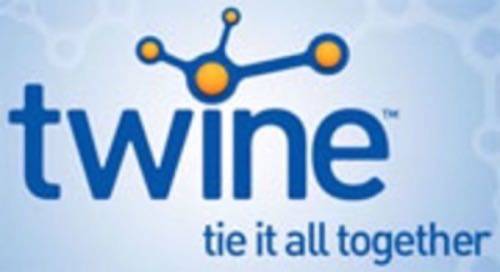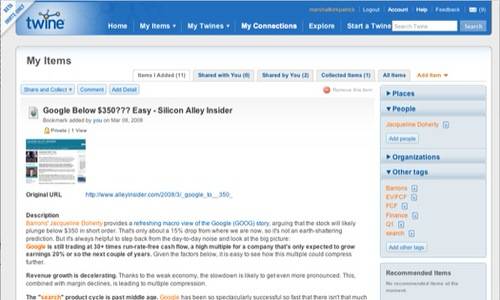Twine is the most hyped semantic app of the season and recently opened up for some press previews. General availability of this smart, social bookmarking and research tool may come in a matter of weeks.

If that’s the case, it will probably be too soon. Twine has some major shortcomings that I think are going to drastically hinder the service’s adoption. Perhaps unsurprisingly, those shortcomings come down to usability and performance. Hopefully these problems will be resolved, but it isn’t going to be easy.
Richard MacManus said months ago that Twine might be the first mainstream semantic web application to hit the market. Semantic technology seems very likely to be key to the future of the web, but Twine demonstrates just how hard it’s going to be for that technology to operate close to the surface of the user interface.
The Basic Idea
Twine looks at content and parses it automatically for the names of people, places, organizations and other subject tags. Users are then able to navigate between related content, view recommended content and connect with recommended people with related interests.
The semantic analysis is faster and smarter than full text search. Making content online machine readable cuts time and thought out of discovery of related information, letting users focus on higher levels of engagement. It’s a great idea and I hope Twine can overcome the issues I’m seeing with it.

Problem: It Doesn’t Work Very Well
The biggest problem with Twine right now may be that it doesn’t work as well as it should. It doesn’t consistently grab summary text or tags for pages you save in Twine, it doesn’t recognize article authors as relevant people and it often captures summary information about the domain you’re on instead of a particular page’s content.
Twine founder Nova Spivack saw that I was saving pages that weren’t coming in with summary information and commented on one of my items that the page at issue was irregularly formatted. That’s why Twine wasn’t able to analyze it, he said. That is a major problem; most of the web is made up of ugly, non-standard pages. Fundamental to the value proposition of a top-down semantic analysis tool should be the ability to discover meaning from unstructured data. Many of the other problems Twine faces will be challenging but do seem solvable. This one could be a deal breaker.
Serious researchers will also be frustrated with the lack of support for authenticated (password protected) pages and the absence of RSS feeds -though feeds may come as soon as the app is public.
Problem: It’s Poorly Organized
Twine has bitten off a whole lot to chew on. It’s an impressive service for the most part. Unfortunately, full-featured social bookmarking is information-dense enough that adding all the semantic features and recommendations from Twine turns information architecture and User Experience into huge challenges.
Twine’s user experience is confusing. It’s hard to keep track of all the levels and types of information available, site navigation is dizzying and my use of the service happened in spite of the interface.
There are a lot of little things Twine could do to help, like defaulting the saved item path to the same category I saved the previous item in.
There are a variety of different approaches already explored in the social bookmarking market. Del.icio.us is simple and does what it says it does, nothing more nothing less. Ma.gnolia does a little bit more, looks great and is relatively self-explanatory. Furl.net was probably better technology than either Del.icio.us or Ma.gnolia but the user experience makes you want to punch some one and the service has withered accordingly. Twine needs to blow this category out of the water but it doesn’t.
I’m sure with some practice I could learn to use Twine more easily, but that’s not an ideal first experience. I don’t feel compelled to keep trying, other than because of my interest in the semantic technology. There’s no visualization, just flat interlinked pages, the only zing to the product today is the recommendation feature.
I would use Twine for recommendation alone, but the value of that feature is minimal until the service finds a large number of users. As it stands, that’s not likely to occur. When it comes to collective organization and discovery of content – nothing is as important as network effect.
Twine’s in closed beta right now – but it’s been in the oven for a long time, has substantial investor backing and is highly anticipated. Despite all that support, it still feels half baked. I hate to say that because everyone says the trouble with the semantic web is that products never come to market – but I don’t think Twine is ready. I don’t know if it ever will be. Someone else may have to be the first mainstream semantic web app – or maybe no one will be. Semantics may be best suited to the back end. I hope Twine, or someone, can bring something like this to market that I want to use.
You can join the long line of people requesting beta access and make your own decision about Twine probably later this month. For a more positive review, see Rafe Needleman’s write up at Webware.





















